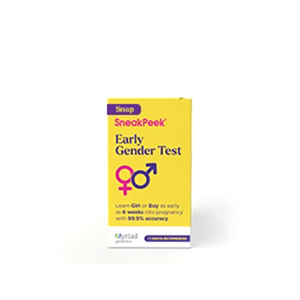Published on October 26th, 2021 and Updated on January 12th, 2024
Check out SneakPeek Gender Test to find out your baby’s gender as early as 6 weeks at over 99% accuracy1!
In the world of parenting, few words can instill fear and distress into the heart of new parents like the mention of the word “colic.” A mystery among medical professionals, colic is a condition that affects approximately 20% of babies. It’s defined by excessive infant crying that isn’t due to any of the usual culprits (i.e. a dirty diaper, an empty tummy, or a pacifier that’s dropped out of sight, never to be found again).
While colic doesn’t pose any short or long-term danger to your baby’s health, it can impact your health, increasing the risk of postpartum depression, as well as feelings of exhaustion and frustration. But don’t break out your own box of tissues just yet! To help ease your fussy baby to sleep (and get some much-needed R&R yourself), keep reading to learn how to comfort a colicky baby with the best sleep positions and sleep-inducing strategies.
Best Sleep Position for Colic Baby
When it comes to your baby, the best sleep position is always the safest sleep position. According to the American Academy of Pediatrics (AAP), babies should be placed on their backs to sleep until they’re 1-year-old to reduce the risk of sudden infant death syndrome (SIDS).
Aside from SIDs, lying down on his back is also the best sleep position for a gassy baby. The congested baby sleep position is also very similar, the only difference is you have to raise the baby’s head to help him breathe easier.
However, colicky babies often have a hard time falling asleep when lying flat on their backs. Because the cause of colic isn’t known, it’s unclear why this is the case, but some doctors believe it’s because colic is caused by excess gas or acid reflux (which can feel worse in a supine position).
Regardless of the reason, if your colic baby loudly protests falling asleep on her back, you can encourage her to fall asleep in the following positions, as long as you monitor while she’s falling asleep, and place her on her back in the crib once she’s snoozing:
- Slightly inclined – Try putting your baby in a swing or bouncer that allows her to rest on an incline. Doing so will appease her back-sleeping protests while also ensuring her safety. While it may be tempting to create an incline in her crib with pillows or rolled-up blankets, these pose a safety hazard (as they increase the risk of suffocation), so it’s better to stick with a swing or bouncer. Plus, the rhythmic motion of swings and bouncers can help lull your little one to sleep.
- Side or stomach – Try placing your baby on her side in your lap, cradling her tummy with one hand, and allowing her head to rest on your forearm. Alternatively, you can place your baby on her stomach, with one arm cradling her belly from beneath. In either position, the slight pressure of your hand against her stomach may help alleviate excess gas and provide additional comfort.
The Five S Strategy
Aside from sleep position, there are other ways you can console your colic baby and encourage him to swap the crying for dreaming. The Five S Strategy has proved particularly effective, as it helps to mimic the cozy, warm, and peaceful experience your baby had in his first home—Mom’s womb (before he was evicted. No wonder he can’t stop crying!).
To recreate the womb in the outside world and comfort your crying baby, try implementing each of the 5 following strategies:
- Swaddling – While the size of your uterus during pregnancy may have seemed above-average to you, for your baby, the space was small and cozy. Outside of the womb, the excessive amount of space may feel too expansive and disconcerting. Swaddling your baby—a technique that involves wrapping your baby securely in a blanket like a little burrito— lets your baby be placed back into the compact position he was accustomed to in the womb, helping him feel calm, relaxed, and safe.
- Shushing – You may be surprised to learn that aside from being small, your baby’s previous living situation was also rather loud. In fact, the sounds your baby heard inside mom’s uterus reached around 80 to 90 decibels—louder than the average vacuum cleaner. So, while it may seem counterintuitive, loudly shushing your baby with your mouth to his ear can actually help soothe him during his sobbing fits. You can also replicate this sound with a white noise machine, a fan, or even a hairdryer.
Another advantage of shushing? It drowns out other sounds that your baby may find unpleasant, like the neighbor’s dog barking outside or a garbage truck loudly collecting trash. When your baby doesn’t have to deal with these types of disruptive and confusing sounds, he can more easily relax.
- Swinging – Like the hypnotic sway of a pocketwatch, slow, smooth motions are extremely relaxing for your little one. If you think about it, it makes sense—inside the womb, your baby was swayed, rocked, and jiggled any time you strolled around the neighborhood, took a morning yoga class, or rocked out to the latest top 40 hits while vacuuming the staircase. That means rocking or bouncing your baby, placing him in a swing, or driving him around in your car can mimic the motions he felt while in your womb.
You can even use a sling to carry him around throughout the day without exhausting your arms (we know they’ve been getting a workout). Not only can a sling provide a calming sway, but it also promotes skin-to-skin contact, which can be just as effective in relaxing your baby. In fact, one study found that babies who were held for 16.5 hours a day cried half as much as babies who were held for only 8 hours a day.
- Side/stomach lying – Laying your baby on his side while holding his stomach, or laying your baby on his stomach, can provide a sensation of pressure similar to what he felt in the confined, cozy space of mom’s womb. You can also try laying your baby against your chest, with his head over your shoulder. Then, rock, sway, or bounce your little guy in this position while shushing in his ear to combine three of the 5 S strategies.
- Sucking – Although infants don’t have to worry about feeding in the womb, once they emerge, their instinct to suck as a way to nourish themselves is strong. By giving your baby a pacifier to suck on, he can satisfy his innate urge to suck even when it’s not mealtime.
Signs Your Baby is Suffering from Colic
Colic usually begins around 2 to 3 weeks after birth, peaking around 6 to 8 weeks and subsiding at approximately 12 to 16 weeks. Typically, the rule of thumb for determining whether your baby has colic is seeing if her crying habits match the rule of threes: inexplicable crying sessions that last for 3 or more hours, at least 3 days a week, for longer than 3 weeks in a row.
Other signs of colic include:
- Burping or passing more gas than normal (as colic babies swallow more air when crying)
- A flushed, red face while crying
- A tight belly
- Clenching fists while crying
If you suspect you have a colicky baby on your hands (or rather, in your arms), your pediatrician can perform tests to rule out other medical possibilities and accurately diagnose your baby with colic.
While doctors aren’t sure of the exact cause of colic, some believe it may be due to:
- A build-up of gas
- Acid reflux
- Indigestion (as the digestive system becomes more developed)
- Sensitivity to formula or breastmilk
- Migraines
- Excessive irritability as your baby adjusts to the outside world
- Heightened sensitivity to light, sounds, and other external stimulation
- Lack of nervous system control
Fortunately, many of these issues will resolve on their own after 16 weeks as your baby develops and adjusts to life outside of the womb. For issues such as gas build-up, acid reflux, and food sensitivities, take a look below at steps you can take to ease symptoms and soothe your baby.
Other Ways to Soothe a Colic Baby
While consoling a colic baby can be challenging, just remember—colic is only temporary. By diagnosing your baby with colic early on, you can find the most effective methods in promoting calmness and encouraging sleep.
Here are a few other helpful tips for soothing your colic baby.
- Burp him often – When your baby cries excessively, he breathes in more air than normal, which can cause uncomfortable bloating and gas (on top of any bloating and gas he may already be struggling with). By burping your baby often, you can prompt belches and alleviate built-up pressure.
- Hold him upright after he eats – If the cause of your little one’s colic is acid reflux, keeping him upright after a meal can reduce the likelihood of breast milk or formula traveling back up his esophagus.
- Ask your pediatrician about probiotics – The gut-friendly bacteria found in probiotics may help reduce instances of indigestion. In fact, one study found that crying decreased by 75% in babies who were given a probiotic consistently over the course of 28 days.
- Switch formulas – Some researchers suggest colic could be caused by a sensitivity or intolerance to milk proteins found in breast milk and formula. By switching to a formula with a different protein source, you may put an end to your baby’s colic, so consider asking your pediatrician about alternative formula options.
- Change your diet – If you’re breastfeeding, your baby’s colic may be due to an adverse reaction to the foods and beverages you consume. To determine if this is the culprit behind those cries, avoid consuming stimulants (like caffeine and chocolate), gas-inducing foods (such as cauliflower), and potential allergens (such as dairy products and nuts). If there’s no change in your baby’s colic after two weeks, your diet is likely not the issue (so you can go back to enjoying those late-night bowls of chocolate ice cream).
Learn More Sleep Secrets with SneakPeek
If a baby sleeping on his back is the safest baby sleep position, what about other sleep positions? If you’re wondering when can babies sleep on their stomach or what to consider if you’re baby is sleeping on his side, read our linked blogs.
By learning the specific sleep positions and strategies that can take your baby from sobbing to subdued, you can successfully navigate the tumultuous waters of colic and emerge on the other side more connected to your little one, with a better understanding of her wants and needs.
This post has been reviewed for accuracy by the following medical professional:
Katie Smith is a seasoned Certified Nurse Midwife and a nurturing mother to six children, offering a unique blend of professional expertise and personal experience. She is the founder of Birth Your Way Midwifery and Women’s Wellness Center in Bay County, Florida. Katie's comprehensive approach to care is informed by her hands-on experience in motherhood and her passion for empowering women through their birthing journey. Her dedication extends beyond her center as she actively engages in community wellness and family health education.
Sources:
- Healthy Children. Colic Relief Tips for Parents. https://www.healthychildren.org/English/ages-stages/baby/crying-colic/Pages/Colic.aspx
- Mayo Clinic. Colic. https://www.mayoclinic.org/diseases-conditions/colic/symptoms-causes/syc-20371074#:~:text=Colic%20does%20not%20cause%20short,of%20postpartum%20depression%20in%20mothers
- Healthy Children. Where We Stand: Back to Sleep. ??https://www.healthychildren.org/English/ages-stages/baby/sleep/Pages/Where-We-Stand-Back-To-Sleep.aspx#:~:text=%E2%80%8B%E2%80%8B%E2%80%8BBased%20on,for%20nap%20time%20or%20nighttime
- University of Iowa Stead Family Children’s Hospital. How to calm your fussy baby. https://uichildrens.org/health-library/how-calm-your-fussy-baby
- Parents. How to Soothe a Colicky Baby. https://www.parents.com/baby/care/colic/how-to-soothe-a-colicky-baby/
- Healthline. 14 Remedies to Try for Colic. https://www.healthline.com/health/childrens-health/best-colic-remedies#causes
- Johns Hopkins Medicine. Colic. https://www.hopkinsmedicine.org/health/conditions-and-diseases/colic

Shop Our Products
SneakPeek aims to provide the most accurate and up-to-date information to help our readers make informed decisions regarding their health before, during, and after pregnancy. This article was written based upon trusted scientific research studies and/or articles. Credible information sources for this article are cited and hyperlinked.






